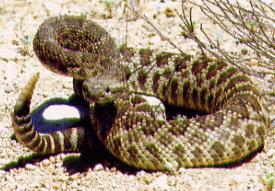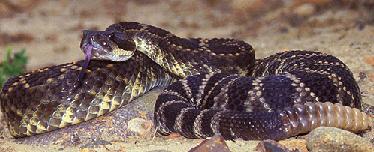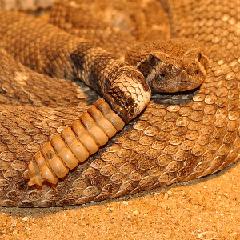Prey evolved adaptation to snake venom
An important aspect of
snake venom evolution is the predator-prey interactions that lead to
venom resistance and
increased venom potency. These interactions lead to an evolutionary
“arms race”
that is further complicated by differing selection pressures among
subpopulations
of prey and predators. A recent paper [1] examines the variations of
venom resistance among two subpopulations of Douglas
squirrels and two subpopulations of Beechey squirrels to the venom of northern
Pacific rattlesnakes, southern Pacific rattlesnakes, and western diamondback
rattlesnakes. One of the Douglas squirrel subpopulations
came from an area with a high density of northern Pacific rattlesnakes while
the other population had an extremely low density of rattlesnake predators. The
two Douglas squirrel subpopulations are estimated to
have diverged about 3,000–15,000 years ago. The two subpopulations of Beechey
squirrels both have high densities of rattlesnake predators with one
subpopulation coming into contact with only the northern Pacific rattlesnake,
while the other comes into contact with both the northern and southern Pacific
rattlesnake. The venom of the southern Pacific rattlesnake was likely used as a
baseline of venom resistance for the Douglas squirrel
subpopulations, as the range of this rattlesnake does not overlap with the Douglas
squirrel subpopulations studied. Likewise, the venom of the western diamondback
rattlesnake was likely used as a baseline of venom resistance for the Beechey
squirrel subpopulations, as the range of this rattlesnake does not overlap with
the Beechey squirrel subpopulations studied.
 
The Northern Pacific Rattlesnake (left,courtesy of the Fresno
Chaffee Zoo) and the Southern Pacific Rattlesnake (right, courtesy of
USGS).
To test the
potency of the rattlesnake venoms, Biardi et al. (2006) measured the metalloprotease
activity (which breaks down the lining of blood vessels), fibrinolysis (which
prevents coagulation by breaking down fibrin clots), and hemolysis (which
breaks open red blood cells), in addition to a radioimmunoassay (RIA). Plasma
from the Douglas squirrel subpopulations was assayed
against northern and southern Pacific rattlesnake venom, the Beechey squirrel
subpopulations were tested against all three rattlesnake venoms. When the venom
of the northern Pacific rattlesnake was assayed with the plasma of the Douglas
squirrel subpopulation with a high density of northern Pacific rattlesnakes, the
venom showed decreased collagen hydrolysis (the assay used to measure
metalloprotease activity) and decreased hemolysis compared to the venom-plasma
assay of the other Douglas squirrel subpopulation.
However, the Douglas squirrel subpopulation with an
extremely low density of northern Pacific rattlesnakes was better able to
inactivate the collagen hydrolysis and fibrinolysis activity of the southern
Pacific rattlesnake venom as compared to the other subpopulation. There were no
statistically significant differences between the Beechey squirrel
subpopulations in any of the venom assays. The results for the Douglas
squirrel subpopulations suggest that increased resistance against the venom of
a specific rattlesnake species comes at the cost of decreased general venom
resistance. It is also interesting to note the level of resistance in the Douglas
squirrel subpopulation with extremely low rattlesnake density to both of the
venoms assayed, even though there is little selective pressure for this
resistance to remain.

Western Diamondback Rattlesnake (Courtesy of Wikimedia Commons)
Resources cited in this section:
1. Biardi,
J.E., Chien D.C.,
& Coss, R.G. California ground squirrel (Spermophilus
beecheyi)
defenses against rattlesnake venom digestive and hemostatic toxins. J. Chem. Ecol. 32, 137-154 (2006).
|